Yansong Feng
Improving Research Idea Generation Through Data: An Empirical Investigation in Social Science
May 27, 2025Abstract:Recent advancements in large language models (LLMs) have shown promise in generating novel research ideas. However, these ideas often face challenges related to feasibility and expected effectiveness. This paper explores how augmenting LLMs with relevant data during the idea generation process can enhance the quality of generated ideas. We introduce two ways of incorporating data: (1) providing metadata during the idea generation stage to guide LLMs toward feasible directions, and (2) adding automatic validation during the idea selection stage to assess the empirical plausibility of hypotheses within ideas. We conduct experiments in the social science domain, specifically with climate negotiation topics, and find that metadata improves the feasibility of generated ideas by 20%, while automatic validation improves the overall quality of selected ideas by 7%. A human study shows that LLM-generated ideas, along with their related data and validation processes, inspire researchers to propose research ideas with higher quality. Our work highlights the potential of data-driven research idea generation, and underscores the practical utility of LLM-assisted ideation in real-world academic settings.
RefTool: Enhancing Model Reasoning with Reference-Guided Tool Creation
May 27, 2025Abstract:Tools enhance the reasoning capabilities of large language models (LLMs) in complex problem-solving tasks, but not all tasks have available tools. In the absence of predefined tools, prior works have explored instructing LLMs to generate tools on their own. However, such approaches rely heavily on the models' internal knowledge and would fail in domains beyond the LLMs' knowledge scope. To address this limitation, we propose RefTool, a reference-guided framework for automatic tool creation that leverages structured external materials such as textbooks. RefTool consists of two modules: (1) tool creation, where LLMs generate executable tools from reference content, validate them using illustrative examples, and organize them hierarchically into a toolbox; and (2) tool utilization, where LLMs navigate the toolbox structure to select and apply the appropriate tools to solve problems. Experiments on causality, physics, and chemistry benchmarks demonstrate that RefTool outperforms existing tool-creation and domain-specific reasoning methods by 11.3% on average accuracy, while being cost-efficient and broadly generalizable. Analyses reveal that grounding tool creation in references produces accurate and faithful tools, and that the hierarchical structure facilitates effective tool selection. RefTool enables LLMs to overcome knowledge limitations, demonstrating the value of grounding tool creation in external references for enhanced and generalizable reasoning.
SchemaAgent: A Multi-Agents Framework for Generating Relational Database Schema
Mar 31, 2025Abstract:The relational database design would output a schema based on user's requirements, which defines table structures and their interrelated relations. Translating requirements into accurate schema involves several non-trivial subtasks demanding both database expertise and domain-specific knowledge. This poses unique challenges for automated design of relational databases. Existing efforts are mostly based on customized rules or conventional deep learning models, often producing suboptimal schema. Recently, large language models (LLMs) have significantly advanced intelligent application development across various domains. In this paper, we propose SchemaAgent, a unified LLM-based multi-agent framework for the automated generation of high-quality database schema. SchemaAgent is the first to apply LLMs for schema generation, which emulates the workflow of manual schema design by assigning specialized roles to agents and enabling effective collaboration to refine their respective subtasks. Schema generation is a streamlined workflow, where directly applying the multi-agent framework may cause compounding impact of errors. To address this, we incorporate dedicated roles for reflection and inspection, alongside an innovative error detection and correction mechanism to identify and rectify issues across various phases. For evaluation, we present a benchmark named \textit{RSchema}, which contains more than 500 pairs of requirement description and schema. Experimental results on this benchmark demonstrate the superiority of our approach over mainstream LLMs for relational database schema generation.
Haste Makes Waste: Evaluating Planning Abilities of LLMs for Efficient and Feasible Multitasking with Time Constraints Between Actions
Mar 04, 2025Abstract:While Large Language Model-based agents have demonstrated substantial progress in task completion, existing evaluation benchmarks tend to overemphasize single-task performance, with insufficient attention given to the crucial aspects of multitask planning and execution efficiency required in real-world scenarios. To bridge this gap, we present Recipe2Plan, a novel benchmark framework based on real-world cooking scenarios. Unlike conventional benchmarks, Recipe2Plan challenges agents to optimize cooking time through parallel task execution while respecting temporal constraints i.e. specific actions need to be performed within a particular time intervals following the preceding steps. Overly aggressive local parallelization may disrupt this constraint, potentially compromising the entire cooking process. This strict time constraint between actions raises a unique challenge for agents to balance between maximizing concurrent operations and adhering to critical timing constraints. Extensive experiments with state-of-the-art models reveal challenges in maintaining this balance between efficiency and feasibility. The results highlight the need for improved temporal awareness and global multitasking capabilities in large language models. We open-source our benchmark and code at https://github.com/WilliamZR/Recipe2Plan.
MiLiC-Eval: Benchmarking Multilingual LLMs for China's Minority Languages
Mar 03, 2025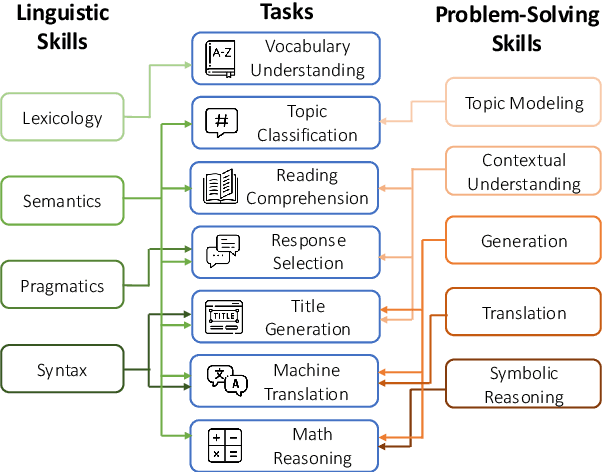

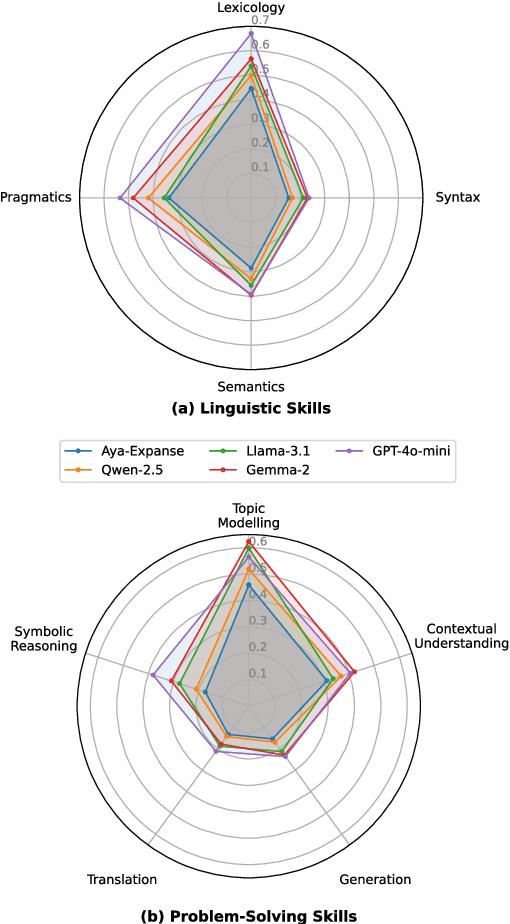
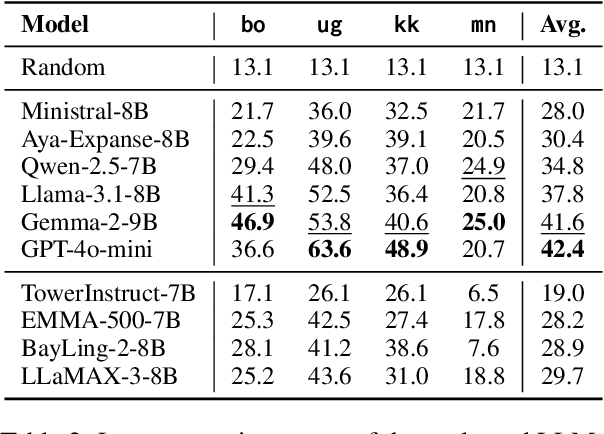
Abstract:Large language models (LLMs) excel in high-resource languages but struggle with low-resource languages (LRLs), particularly those spoken by minority communities in China, such as Tibetan, Uyghur, Kazakh, and Mongolian. To systematically track the progress in these languages, we introduce MiLiC-Eval, a benchmark designed for minority languages in China, featuring 24K instances across 9 tasks. MiLiC-Eval focuses on underrepresented writing systems and provides a fine-grained assessment of linguistic and problem-solving skills. Our evaluation reveals that LLMs perform poorly on syntax-intensive tasks and multi-script languages. We further demonstrate how MiLiC-Eval can help advance LRL research in handling diverse writing systems and understanding the process of language adaptation.
Automated Annotation of Evolving Corpora for Augmenting Longitudinal Network Data: A Framework Integrating Large Language Models and Expert Knowledge
Mar 03, 2025Abstract:Longitudinal network data are essential for analyzing political, economic, and social systems and processes. In political science, these datasets are often generated through human annotation or supervised machine learning applied to evolving corpora. However, as semantic contexts shift over time, inferring dynamic interaction types on emerging issues among a diverse set of entities poses significant challenges, particularly in maintaining timely and consistent annotations. This paper presents the Expert-Augmented LLM Annotation (EALA) approach, which leverages Large Language Models (LLMs) in combination with historically annotated data and expert-constructed codebooks to extrapolate and extend datasets into future periods. We evaluate the performance and reliability of EALA using a dataset of climate negotiations. Our findings demonstrate that EALA effectively predicts nuanced interactions between negotiation parties and captures the evolution of topics over time. At the same time, we identify several limitations inherent to LLM-based annotation, highlighting areas for further improvement. Given the wide availability of codebooks and annotated datasets, EALA holds substantial promise for advancing research in political science and beyond.
JUREX-4E: Juridical Expert-Annotated Four-Element Knowledge Base for Legal Reasoning
Feb 24, 2025Abstract:The Four-Element Theory is a fundamental framework in criminal law, defining the constitution of crime through four dimensions: Subject, Object, Subjective aspect, and Objective aspect. This theory is widely referenced in legal reasoning, and many Large Language Models (LLMs) attempt to incorporate it when handling legal tasks. However, current approaches rely on LLMs' internal knowledge to incorporate this theory, often lacking completeness and representativeness. To address this limitation, we introduce JUREX-4E, an expert-annotated knowledge base covering 155 criminal charges. It is structured through a progressive hierarchical annotation framework that prioritizes legal source validity and employs diverse legal interpretation methods to ensure comprehensiveness and authority. We evaluate JUREX-4E on the Similar Charge Distinction task and apply it to Legal Case Retrieval, demonstrating its effectiveness in improving LLM performance. Experimental results validate the high quality of JUREX-4E and its substantial impact on downstream legal tasks, underscoring its potential for advancing legal AI applications. Code: https://github.com/THUlawtech/JUREX
Automating Legal Concept Interpretation with LLMs: Retrieval, Generation, and Evaluation
Jan 03, 2025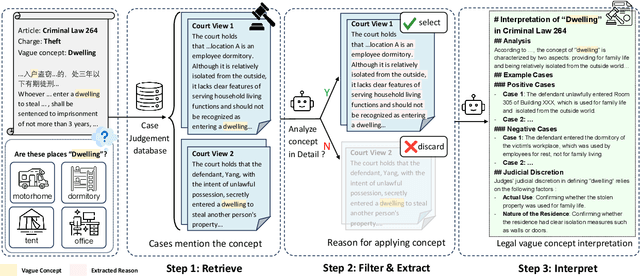

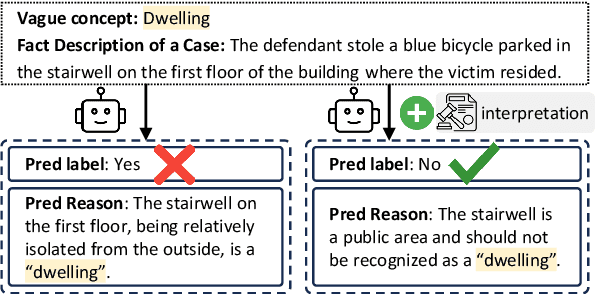
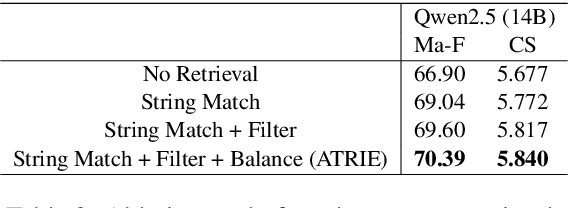
Abstract:Legal articles often include vague concepts to adapt to the ever-changing society. Providing detailed interpretations of these concepts is a critical task for legal practitioners, which requires meticulous and professional annotations by legal experts, admittedly time-consuming and expensive to collect at scale. In this paper, we introduce a novel retrieval-augmented generation framework, ATRI, for AuTomatically Retrieving relevant information from past judicial precedents and Interpreting vague legal concepts. We further propose a new benchmark, Legal Concept Entailment, to automate the evaluation of generated concept interpretations without expert involvement. Automatic evaluations indicate that our generated interpretations can effectively assist large language models (LLMs) in understanding vague legal concepts. Multi-faceted evaluations by legal experts indicate that the quality of our concept interpretations is comparable to those written by human experts. Our work has strong implications for leveraging LLMs to support legal practitioners in interpreting vague legal concepts and beyond.
Only One Relation Possible? Modeling the Ambiguity in Event Temporal Relation Extraction
Aug 14, 2024Abstract:Event Temporal Relation Extraction (ETRE) aims to identify the temporal relationship between two events, which plays an important role in natural language understanding. Most previous works follow a single-label classification style, classifying an event pair into either a specific temporal relation (e.g., \textit{Before}, \textit{After}), or a special label \textit{Vague} when there may be multiple possible temporal relations between the pair. In our work, instead of directly making predictions on \textit{Vague}, we propose a multi-label classification solution for ETRE (METRE) to infer the possibility of each temporal relation independently, where we treat \textit{Vague} as the cases when there is more than one possible relation between two events. We design a speculation mechanism to explore the possible relations hidden behind \textit{Vague}, which enables the latent information to be used efficiently. Experiments on TB-Dense, MATRES and UDS-T show that our method can effectively utilize the \textit{Vague} instances to improve the recognition for specific temporal relations and outperforms most state-of-the-art methods.
ELLA: Empowering LLMs for Interpretable, Accurate and Informative Legal Advice
Aug 13, 2024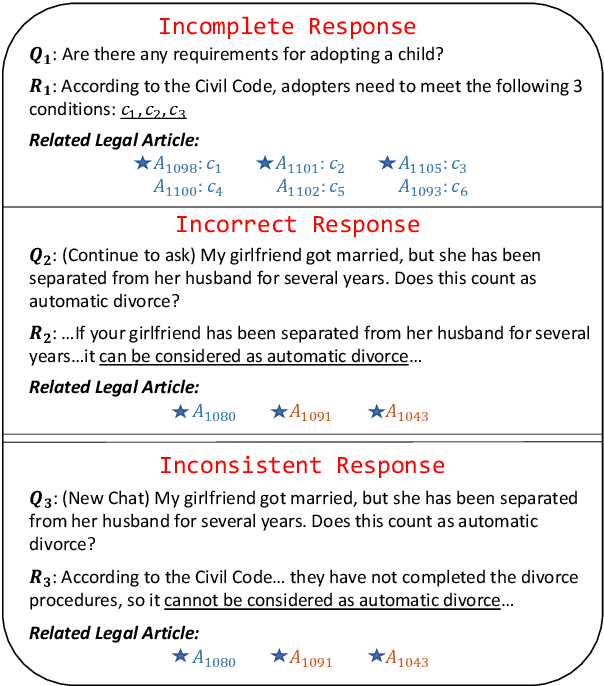
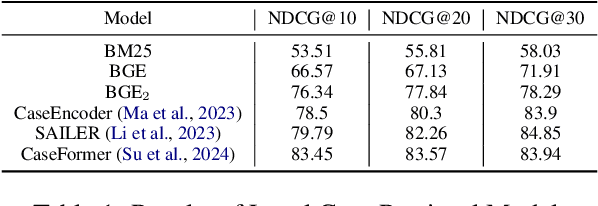
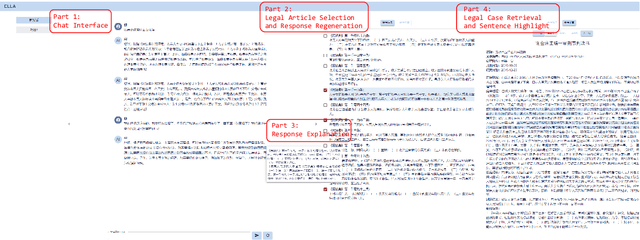
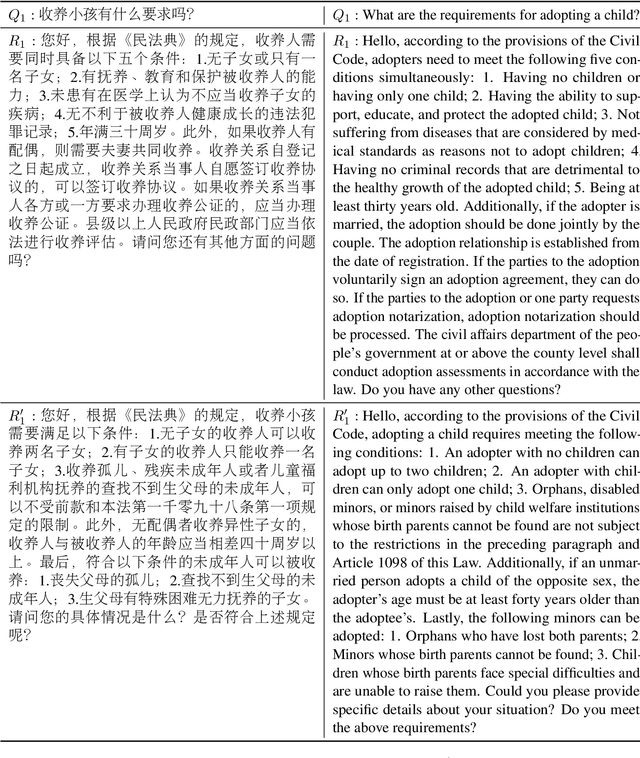
Abstract:Despite remarkable performance in legal consultation exhibited by legal Large Language Models(LLMs) combined with legal article retrieval components, there are still cases when the advice given is incorrect or baseless. To alleviate these problems, we propose {\bf ELLA}, a tool for {\bf E}mpowering {\bf L}LMs for interpretable, accurate, and informative {\bf L}egal {\bf A}dvice. ELLA visually presents the correlation between legal articles and LLM's response by calculating their similarities, providing users with an intuitive legal basis for the responses. Besides, based on the users' queries, ELLA retrieves relevant legal articles and displays them to users. Users can interactively select legal articles for LLM to generate more accurate responses. ELLA also retrieves relevant legal cases for user reference. Our user study shows that presenting the legal basis for the response helps users understand better. The accuracy of LLM's responses also improves when users intervene in selecting legal articles for LLM. Providing relevant legal cases also aids individuals in obtaining comprehensive information.
 Add to Chrome
Add to Chrome Add to Firefox
Add to Firefox Add to Edge
Add to Edge